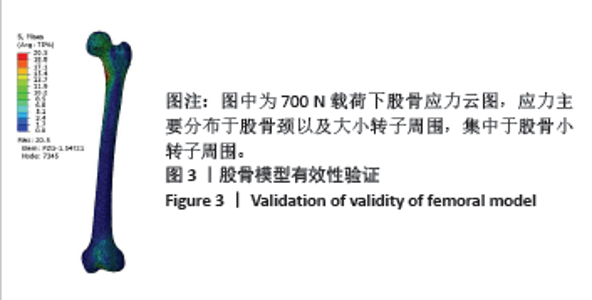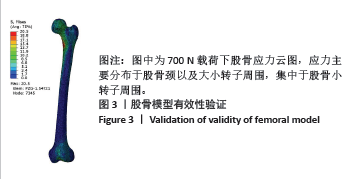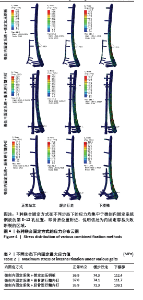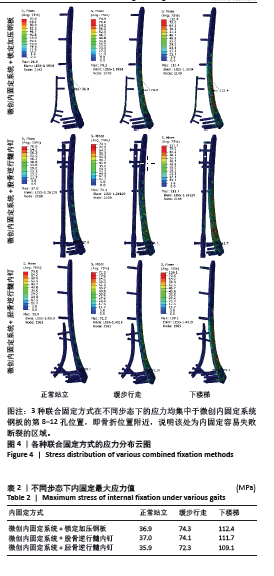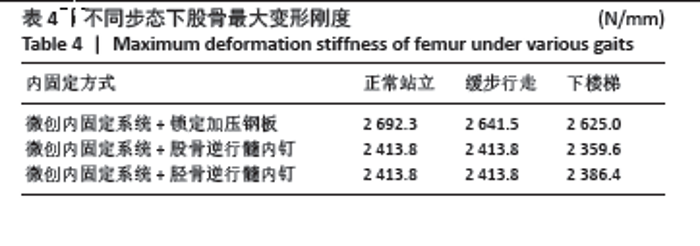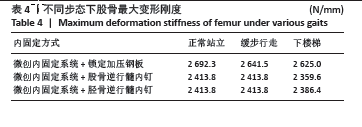Chinese Journal of Tissue Engineering Research ›› 2025, Vol. 29 ›› Issue (27): 5728-5734.doi: 10.12307/2025.805
Previous Articles Next Articles
Finite element analysis of three internal fixation methods for type AO/OTA A3 distal femoral fractures
Zhang Jinhui, Liu Hui, Xu Weizhen, Xiong Yuanfei, Zhang Jianping, Wu Jin
- Department of Orthopedics, 909 Hospital, Dongnan Hospital of Xiamen University, Zhangzhou 363000, Fujian Province, China
-
Received:2024-04-22Accepted:2024-06-29Online:2025-09-28Published:2025-02-26 -
Contact:Wu Jin, PhD, Associate chief physician, Department of Orthopedics, 909 Hospital, Dongnan Hospital of Xiamen University, Zhangzhou 363000, Fujian Province, China -
About author:Zhang Jinhui, MS, Attending physician, Department of Orthopedics, 909 Hospital, Dongnan Hospital of Xiamen University, Zhangzhou 363000, Fujian Province, China
CLC Number:
Cite this article
Zhang Jinhui, Liu Hui, Xu Weizhen, Xiong Yuanfei, Zhang Jianping, Wu Jin. Finite element analysis of three internal fixation methods for type AO/OTA A3 distal femoral fractures[J]. Chinese Journal of Tissue Engineering Research, 2025, 29(27): 5728-5734.
share this article
Add to citation manager EndNote|Reference Manager|ProCite|BibTeX|RefWorks
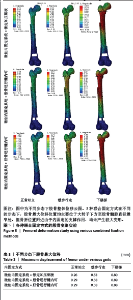
2.3 股骨变形位移结果 在不同步态下,股骨由于受压产生弯曲,最大位移位置主要位于大转子下方横截面积较小位置,骨折位置附近由于内固定的支撑作用,未产生较大变形。3种联合内固定方式无论是正常站立、缓步行走还是下楼梯情况下,微创内固定系统+锁定加压钢板组股骨整体位移量最小,其抗变形能力最小;微创内固定系统+股骨逆行髓内钉与微创内固定系统+胫骨逆行髓内钉抗变形能力相当,相比微创内固定系统+锁定加压钢板内固定方式,抗变形能力降低10%左右;微创内固定系统+胫骨逆行髓内钉内固定方式抗变形能力虽然低于微创内固定系统+锁定加压钢板 10%左右,但是与已有内固定方式微创内固定系统+股骨逆行髓内钉相当,其具备一定的抗变形能力,且相比其他两种内固定失效风险最低,见图5及表3。"
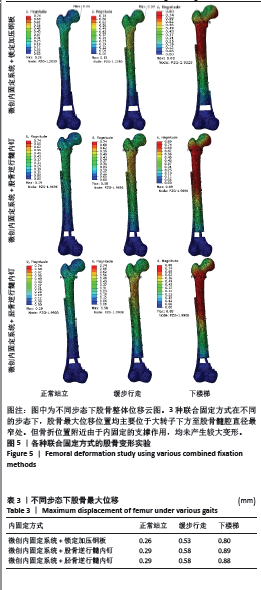
| [1] ELSOE R, CECCOTTI AA, LARSEN P. Population-based epidemiology and incidence of distal femur fractures. Int Orthop. 2018;42(1):191-196. [2] SINGH R, AMBADE R, LANDGE S, et al. Comprehensive Review on Distal Femur Fractures: From Epidemiology to Treatment Strategies. Cureus. 2024;16(4):e57937. [3] HAKE ME, DAVIS ME, PERDUE AM, et al. Modern Implant Options for the Treatment of Distal Femur Fractures. J Am Acad Orthop Surg. 2019; 27(19):e867-e875. [4] NESTER M, BORRELLI J JR. Distal femur fractures management and evolution in the last century. Int Orthop. 2023;47(8):2125-2135. [5] RINEHART D, YOUNGMAN T, AHN J, et al. Review of patient-reported outcomes in periprosthetic distal femur fractures after total knee arthroplasty: a plate or intramedullary nail? Arthroplasty. 2021; 3(1):24. [6] TAMPERE T, OLLIVIER M, JACQUET C, et al. Knee arthroplasty for acute fractures around the knee. EFORT Open Rev. 2020;5(10):713-723. [7] TAHAMI M, VAZIRI AS, TAHMASEBI MN, et al. Practical approach to the native distal femur fractures in the elderly: A rapid review over the recent trends. Injury. 2022;53(7):2389-2394. [8] WILSON JL, SQUIRES M, MCHUGH M, et al. The geriatric distal femur fracture: nail, plate or both? Eur J Orthop Surg Traumatol. 2023;33(5): 1485-1493. [9] ABDELMONEM AH, SABER AY, EI SAGHEIR M, et al. Evaluation of the Results of Minimally Invasive Plate Osteosynthesis Using a Locking Plate in the Treatment of Distal Femur Fractures. Cureus. 2022;14(3):e23617. [10] GURUNG R, TERRILL A, WHITE G, et al. Severity of Complications after Locking Plate Osteosynthesis in Distal Femur Fractures. J Clin Med. 2024;13(5):1492. [11] PFEUFER D, ZELLER A, MEHAFFEY S, et al. Weight-bearing restrictions reduce postoperative mobility in elderly hip fracture patients. Arch Orthop Trauma Surg. 2019;139(9):1253-1259. [12] SAIN A, SHARMA V, FAROOQUE K, et al. Dual Plating of the Distal Femur: Indications and Surgical Techniques. Cureus. 2019;11(12): e6483. [13] 孟亚强, 岳晓东. 单一切口双钢板治疗股骨远端粉碎性骨折的疗效[J]. 临床骨科杂志,2024,27(1):97-101. [14] 曹浙标, 季烈峰, 任伟峰. 外侧微创内固定系统联合内侧重建钢板内固定治疗股骨远端骨折的疗效观察[J]. 中国骨与关节损伤杂志, 2022,37(8):838-840. [15] KONTAKIS MG, GIANNOUDIS PV. Nail plate combination in fractures of the distal femur in the elderly: A new paradigm for optimum fixation and early mobilization? Injury. 2023;54(2):288-291. [16] PASSIAS BJ, EMMER TC, SULLIVAN BD, et al. Treatment of Distal Femur Fractures with a Combined Nail-Plate Construct: Techniques and Outcomes. J Long Term Eff Med Implants. 2021;31(3):15-26. [17] UPADHYAY P, SYED F, RAMOUTRA DN, et al. The missing piece of the trauma armoury-medial femoral condyle plate. Injury. 2022;53(3): 1237-1240. [18] ROLLOCK NC, GADINSKY NE, KLINGER CE, et al. The effects of dual plating on the vascularity of the distal femur. Bone Joint J. 2020; 102-B(4):530-538 [19] PENG B, WAN T, TAN W, et al. Novel Retrograde Tibial Intramedullary Nailing for Distal Tibial Fractures. Front Surg. 2022;9:899483. [20] 熊远飞, 刘晖, 许遵营, 等. 胫骨逆行髓内钉在高危人群胫骨远端关节外骨折中的应用研究[J]. 骨科,2024,15(1):71-75. [21] GREENFIELD J, APPELMANN P, WUNDERLICH F, et al. Retrograde tibial nailing of far distal tibia fractures: a biomechanical evaluation of double- versus triple-distal interlocking. Eur J Trauma Emerg Surg. 2022;48(5):3693-3700. [22] WRIGHT DJ, DESANTO DJ, MCGARRY MH, et al. Supplemental Fixation of Supracondylar Distal Femur Fractures: A Biomechanical Comparison of Dual-Plate and Plate-Nail Constructs. J Orthop Trauma. 2020;34(8):434-440. [23] 汪金平, 杨天府, 钟凤林,等. 股骨生物力学特性的有限元分析[J]. 中华创伤骨科杂志,2005,7(10):931-934. [24] 陈柄泽. 不同骨折复位质量下垂直型股骨颈骨折四种不同内固定方式治疗的有限元分析[D].广州: 南方医科大学,2022. [25] WOLFRAM U, SCHWIEDRZIK J. Post-yield and failure properties of cortical bone. Bonekey Rep. 2016;5:829. [26] 李瑞扬,罗从风. 双钢板内固定治疗股骨远端骨折研究进展[J].国际骨科学杂志,2021,42(6):329-332. [27] ESPEY R, STEVENSON L, TUCKER A. Combined nail-plate constructs in the management of osteoporotic native distal femoral fractures: a systematic review of the available evidence. Eur J Orthop Surg Traumatol. 2023;33(8):3215-3223. [28] STOFFEL K, SOMMER C, LEE M, et al. Double fixation for complex distal femoral fractures. EFORT Open Rev. 2022;7(4):274-286. [29] LIPORACE FA, ANEJA A, CARROLL EA, et al. Maintaining the Neutral Axis in the Treatment of Distal Femur Fractures Via Dual Plate or Nail Plate Combination Technique: When and How? J Orthop Trauma. 2021;35(Suppl 5):S38-S40. [30] CHEN MJ, GOODNOUGH LH, SALAZAR BP, et al. Impact on periosteal vasculature after dual plating of the distal femur: a cadaveric study. OTA Int. 2021;4(2):e131. [31] SHI BY, BRODKE DJ, O’HARA N, et al. Nail Plate Combination Fixation Versus Lateral Locked Plating for Distal Femur Fractures: A Multicenter Experience. J Orthop Trauma. 2023;37(11):562-567. [32] 谢威,黄子阳,黄泽茂,等. 微创内固定系统与逆行髓内钉内固定治疗股骨远端骨折的Meta分析[J]. 中国骨与关节损伤杂志,2022, 37(4):355-358. [33] QUINZI DA, CHILDS S, LIPOF JS, et al. The Treatment of Periprosthetic Distal Femoral Fractures After Total Knee Replacement: A Critical Analysis Review. JBJS Rev. 2020;8(9):e2000003. [34] 徐志,仲鹤鹤,向浩,等. 股骨干骨折3种不同固定方式的有限元分析[J]. 中国组织工程研究,2022,26(33):5271-5277. [35] 史方石,袁维. 有限元法在骨科器械和植入物中的应用综述[J].科学技术与工程,2023,23(30):12775-12785. [36] 胡浩,陆骅.有限元分析在股骨远端骨折内固定中的应用研究进展[J].实用临床医药杂志,2023,27(6):145-148. [37] 陈丁,于娇娜,于洋,等. 有限元分析3种内固定方式治疗伴有内侧骨缺损的C3型股骨远端骨折[J]. 中南大学学报(医学版),2023, 48(11):1711-1720. [38] 卢俊浩,时宁文,柏茂盛,等. 三种不同内固定方案治疗股骨远端粉碎性骨折疗效及安全性的研究[J]. 创伤外科杂志,2022,24(10): 770-776. [39] YU X, GUO Y, KANG Q, et al. Effects and mechanisms of mechanical stress on secondary fracture healing. Front Biosci (Landmark Ed). 2013;18(4):1344-1348. [40] 蔡成阔,石博文,计国旗,等. 环形外固定架对长骨斜形骨折断端固定效果的生物力学研究[J]. 中华骨科杂志,2021,41(22): 1640-1646. |
| [1] | Liu Wenlong, Dong Lei, Xiao Zhengzheng, Nie Yu. Finite element analysis of tibial prosthesis loosening after fixed-bearing unicompartmental knee arthroplasty for osteoporosis [J]. Chinese Journal of Tissue Engineering Research, 2026, 30(9): 2191-2198. |
| [2] | Zheng Wangyang, Fei Ji, Yang Di, Zhao Lang, Wang Lingli, Liu Peng, Li Haiyang. Finite element analysis of the force changes of the supraspinatus tendon and glenohumeral joint during the abduction and flexion of the humerus [J]. Chinese Journal of Tissue Engineering Research, 2026, 30(9): 2199-2207. |
| [3] | Cai Qirui, Dai Xiaowei, Zheng Xiaobin, Jian Sili, Lu Shaoping, Liu Texi, Liu Guoke, Lin Yuanfang. Mechanical effects of Long’s traction orthopedic method on cervical functional units: quantitative analysis of biomechanical model of head and neck [J]. Chinese Journal of Tissue Engineering Research, 2026, 30(9): 2208-2216. |
| [4] | Rao Jingcheng, Li Yuwan, Zheng Hongbing, Xu Zhi, Zhu Aixiang, Shi Ce, Wang Bing, Yang Chun, Kong Xiangru, Zhu Dawei. Biomechanical differences between the new proximal femoral stable intramedullary nail and traditional intramedullary nail#br# [J]. Chinese Journal of Tissue Engineering Research, 2026, 30(9): 2217-2225. |
| [5] | Chen Long, Wang Xiaozhen, Xi Jintao, Lu Qilin. Biomechanical performance of short-segment screw fixation combined with expandable polyetheretherketone vertebral body replacement in osteoporotic vertebrae [J]. Chinese Journal of Tissue Engineering Research, 2026, 30(9): 2226-2235. |
| [6] | Yan Xiangning, Chen Lei, Chen Yonghuan, Wang Chao, Li Xiaosheng. Influence of different depths and loads on knee joint mechanics and peripheral muscle force characteristics during squatting [J]. Chinese Journal of Tissue Engineering Research, 2026, 30(9): 2236-2247. |
| [7] | Chen Huiting, Zeng Weiquan, Zhou Jianhong, Wang Jie, Zhuang Congying, Chen Peiyou, Liang Zeqian, Deng Weiming. Tail anchoring technique of vertebroplasty in treatment of osteoporotic vertebral compression fractures with intravertebral cleft: a finite element analysis [J]. Chinese Journal of Tissue Engineering Research, 2026, 30(9): 2145-2152. |
| [8] | Zeng Xuan, Weng Rui, Ye Shicheng, Tang Jiadong, Mo Ling, Li Wenchao. Two lumbar rotary manipulation techniques in treating lumbar disc herniation: a finite element analysis of biomechanical differences [J]. Chinese Journal of Tissue Engineering Research, 2026, 30(9): 2153-2161. |
| [9] | Cheng Qisheng, Julaiti·Maitirouzi, Xiao Yang, Zhang Chenwei, Paerhati·Rexiti. Finite element analysis of novel variable-diameter screws in modified cortical bone trajectory of lumbar vertebrae [J]. Chinese Journal of Tissue Engineering Research, 2026, 30(9): 2162-2171. |
| [10] | Wu Hongxu, Liu Xuanyu, Wang Taoyu, Wang Shiyao, Cheng Jingyi, Zhang Mingwen, Zhang Yinxia, Liu Zhihua, Wang Xiaojie. Finite element simulation of scoliosis with muscle unit introduction: verification of correction effect under bidirectional load [J]. Chinese Journal of Tissue Engineering Research, 2026, 30(9): 2172-2181. |
| [11] | Liu Jiafu, Ren Ruxia, Liao Zhouwei, Zhou Xiali, Wu Yihong, Zhang Shaoqun. Three-dimensional finite element analysis of cervical spine biomechanical characteristics in a rat model of cervical vertigo [J]. Chinese Journal of Tissue Engineering Research, 2026, 30(9): 2182-2190. |
| [12] | Zhou Daobin, Wang Kehao, Xie Yang, Ning Rende. Biomechanical characteristics of volar locking plate only versus combined dorsal mini-plate fixation of distal radius fractures with dorsal ulnar fragment [J]. Chinese Journal of Tissue Engineering Research, 2026, 30(9): 2255-2261. |
| [13] | Zheng Xuying, Hu Hongcheng, Xu Libing, Han Jianmin, Di Ping. Stress magnitude and distribution in two-piece cement-retained zirconia implants under different loading conditions and with varying internal connection shapes [J]. Chinese Journal of Tissue Engineering Research, 2026, 30(8): 1979-1987. |
| [14] | Zhong Caihong, Xiao Xiaoge, Li Ming, Lin Jianhong, Hong Jing. Biomechanical mechanism of sports-related patellar tendinitis [J]. Chinese Journal of Tissue Engineering Research, 2026, 30(6): 1417-1423. |
| [15] | Xu Hao, Ding Lu, Li Xiao. Mechanical effect of mechanical wear of abutment screws on the Morse taper connection implant system: a three-dimensional finite element analysis [J]. Chinese Journal of Tissue Engineering Research, 2026, 30(6): 1375-1383. |
| Viewed | ||||||
|
Full text |
|
|||||
|
Abstract |
|
|||||
